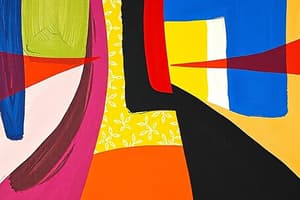Podcast
Questions and Answers
Las artes creativas en la educación preescolar son importantes para fomentar el crecimiento y desarrollo de los niños.
Las artes creativas en la educación preescolar son importantes para fomentar el crecimiento y desarrollo de los niños.
True (A)
Las actividades artísticas en la educación preescolar incluyen exclusivamente arte visual y música.
Las actividades artísticas en la educación preescolar incluyen exclusivamente arte visual y música.
False (B)
Es recomendable que los educadores proporcionen un ambiente completamente sin estructura para el aprendizaje artístico en la primera infancia.
Es recomendable que los educadores proporcionen un ambiente completamente sin estructura para el aprendizaje artístico en la primera infancia.
False (B)
El enfoque Reggio Emilia considera que los niños deben seguir estrictamente las instrucciones del maestro al realizar actividades artísticas.
El enfoque Reggio Emilia considera que los niños deben seguir estrictamente las instrucciones del maestro al realizar actividades artísticas.
En el enfoque Reggio Emilia, las lecciones son un proceso de indagación colaborativa donde los profesores estimulan la curiosidad de los niños.
En el enfoque Reggio Emilia, las lecciones son un proceso de indagación colaborativa donde los profesores estimulan la curiosidad de los niños.
Las artes creativas en la educación preescolar no contribuyen al desarrollo de la auto-motivación y el pensamiento independiente en los jóvenes estudiantes.
Las artes creativas en la educación preescolar no contribuyen al desarrollo de la auto-motivación y el pensamiento independiente en los jóvenes estudiantes.
Es importante ofrecer materiales que no requieran mucha coordinación motora fina para los niños en preescolar.
Es importante ofrecer materiales que no requieran mucha coordinación motora fina para los niños en preescolar.
La pintura es difícil de manejar para los estudiantes si usan pinceles pequeños.
La pintura es difícil de manejar para los estudiantes si usan pinceles pequeños.
Los bloques magnéticos son un ejemplo de materiales apropiados para el desarrollo en preescolares.
Los bloques magnéticos son un ejemplo de materiales apropiados para el desarrollo en preescolares.
Las unidades temáticas en educación artística creativa no integran todas las asignaturas bajo un mismo tema principal.
Las unidades temáticas en educación artística creativa no integran todas las asignaturas bajo un mismo tema principal.
La educación artística creativa en preescolares no se ha relacionado con tasas de graduación más altas.
La educación artística creativa en preescolares no se ha relacionado con tasas de graduación más altas.
Al incorporar la creatividad en la educación infantil, sentamos las bases para el éxito académico futuro.
Al incorporar la creatividad en la educación infantil, sentamos las bases para el éxito académico futuro.
Flashcards are hidden until you start studying
Study Notes
Creative Arts in Preschool Education
Creative arts in preschool education plays a vital role in fostering children's growth and development. It refers to activities that involve artistic expression, such as visual art, dance, music, theater, and creative writing. These activities are essential for encouraging self-expression, problem-solving, and social-emotional development. Let's delve deeper into the importance of creative arts in preschool education.
Structured Environment with Open-Ended Exploration
In early childhood education, it is widely recommended for educators to provide a structured environment for arts learning while allowing for open-ended exploration within that time frame. This balance between structure and freedom enables children to engage in creative activities at their own pace and in their own ways. It also supports the Reggio Emilia approach, which views the classroom as a teacher in itself, where materials are carefully selected and arranged to support learning, but children are not dictated what they should do with them. Instead, lessons are a process of collaborative inquiry where teachers pose ideas and situations to stimulate children's curiosity, and students' responses, ideas, questions then inform the direction of the art experience. This approach fosters self-motivation and independent thinking among young learners.
Age-Appropriate Media and Techniques
Educators should offer materials to preschoolers that do not require much fine motor coordination to manipulate, such as thick crayons, markers, clay, or blocks. Paint is also easy for students to handle if their brushes are big enough. The choice of age-appropriate media and techniques helps ensure that all students can participate in creative activities without feeling overwhelmed by complex tasks.
Developmentally Appropriate Materials
Incorporating developmentally appropriate materials into preschool classrooms ensures that children are engaged in hands-on activities that match their stage of development and ability. These materials can encourage children to experiment, engage, and solve problems. Examples of developmentally appropriate materials include wooden and magnetic blocks for building, baby dolls, balls of various shapes and sizes, floor puzzles with large pieces, and simple games without reading or few pieces like Chutes and Ladders. It's important to choose a variety of materials that cater to different interests and skill levels among preschoolers.
Thematic Units in Creative Arts Education
Thematic units in creative arts education integrate all subjects across one main theme for a balanced curriculum. They enhance children's comprehension by making learning interactive and integrated. When planning thematic units, consider factors such as children's interests, their learning level, goals you want to achieve, materials needed, activities to develop, book selection, discussion questions, and assessment methods. By focusing on themes like animals, community helpers, colors, or self-portraits, educators can create engaging lessons that teach students new skills while keeping them motivated and curious about their world.
Importance of Creative Arts Education
Creative arts education in preschools have been linked to higher graduation rates, increased community engagement, and pro-social activities across the lifespan. It strengthens research efforts linking arts to overall health and well-being throughout life. By incorporating creativity into early childhood education, we lay the foundation for future academic success, social skills, emotional intelligence, and a lifelong appreciation for the arts.
Studying That Suits You
Use AI to generate personalized quizzes and flashcards to suit your learning preferences.




